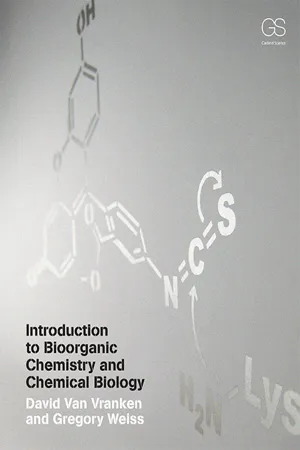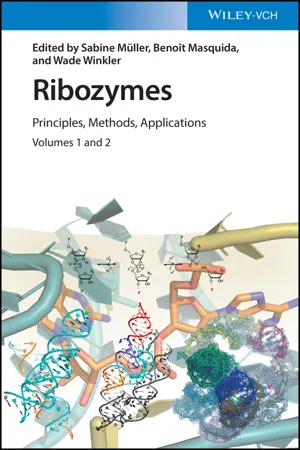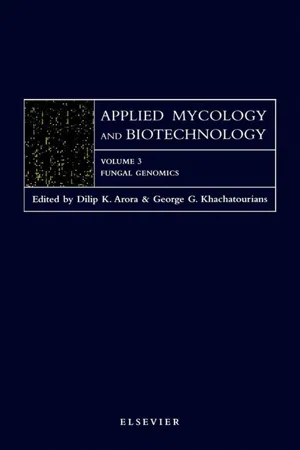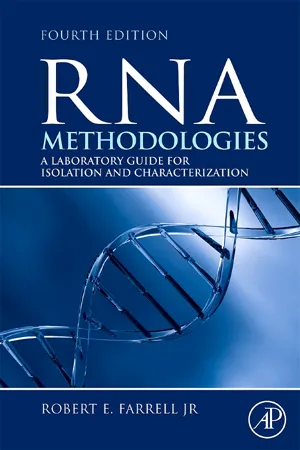Chemistry
Ribosomal RNA
Ribosomal RNA (rRNA) is a type of RNA that is a component of the ribosome, the cellular organelle where protein synthesis occurs. It plays a crucial role in the translation of genetic information from messenger RNA (mRNA) into proteins. Ribosomal RNA helps to catalyze the formation of peptide bonds between amino acids during protein synthesis.
Written by Perlego with AI-assistance
Related key terms
8 Key excerpts on "Ribosomal RNA"
- eBook - ePub
RNA Methodologies
Laboratory Guide for Isolation and Characterization
- Robert E. Farrell Jr.(Author)
- 2017(Publication Date)
- Academic Press(Publisher)
In prokaryotic cells the major rRNA species are the 23S rRNA, 16S rRNA, and 5S rRNA. The eukaryotic counterparts are identified as the 28S rRNA, 18S rRNA, and 5S rRNA, as well as a fourth ribosomal transcript, the 5.8S rRNA. These molecules form the scaffolding of ribosomes, which become translationally competent when decorated with myriad ribosomal proteins. At present there are 55 known prokaryotic ribosomal proteins and 82 known eukaryotic (mammalian) ribosomal proteins. Not all ribosomes are functional at any given time, and the existence of a pool of transiently inactive ribosomes is itself a regulator of gene expression. The super abundance of rRNA in a purified RNA sample is often used as both an RNA mass loading control (see Chapter 9 : Quantitative PCR Techniques) as well as internal electrophoresis molecular weight markers (see Chapter 13 : Electrophoresis of RNA). tRNA is responsible for the transportation of amino acids to the ribosome to support protein synthesis. Amino acid molecules are small, ordinarily ranging from 74 to 95 nts. When shuttling an amino acid covalently linked to its 3′ end, a tRNA is said to be “charged”. Placement of the correct amino acid into the nascent polypeptide depends on recognition of the mRNA codon (a group of three nucleotides) within the coding region of mRNA by a complementary trinucleotide motif carried on one arm of the tRNA known as the anticodon. The tRNA anticodon base pairs to the mRNA codon within the ribosome, thereby supporting protein elongation (for review, see Krebs et al., 2012). While neither as large nor as abundant as rRNA, the smaller tRNA species play a central role in translation. mRNA is the most diverse of all the transcripts. Ironically, even though mRNA is by far the least abundant of all transcript types, it is the mRNA that drives the phenotype of the cell. mRNA alone directs the synthesis of proteins through the use of the cellular translation apparatus - Tina M. Henkin, Joseph E. Peters(Authors)
- 2020(Publication Date)
- ASM Press(Publisher)
The ribosomes are some of the largest structures in bacterial cells and are composed of both proteins and RNA. Bacterial ribosomes contain three types of rRNA: 16S, 23S, and 5S. The S value (from Svedberg, the name of the person who pioneered this way of measuring the sizes of molecules) is a measure of how fast a molecule sediments in an ultracentrifuge. In general, the higher the S value, the larger the RNA. The designation has persisted, even though this method of measuring molecular size is rarely used.The rRNAs are among the most highly evolutionarily conserved of all the cellular constituents, as indeed are many of the components of the translational machinery. For this reason, they have formed the basis for molecular phylogeny (Box 2.2 ). Comparisons of the sequences of rRNAs and other constituents of the translation apparatus from different species permit estimates to be made of how long ago these constituents separated evolutionarily.In addition to their structural role in the ribosome, the rRNAs play a direct role in translation. The 23S rRNA is the peptidyltransferase enzyme, which joins amino acids into protein on the ribosome. The 23S rRNA therefore acts as a ribozyme , an RNA enzyme (see below). The 16S RNA lacks enzymatic activity but plays crucial roles in initiation and termination of translation, as well as in decoding of the sequence of the mRNA.The rRNAs and tRNAs make up the bulk of the RNA in cells because of their central role in protein synthesis. In a rapidly growing bacterial cell, much of the total RNA synthesis is devoted to making these RNAs. Also, the rRNAs and tRNAs are far more resistant to degradation than mRNA. With this combination of a high synthesis rate and high stability, the rRNAs and tRNAs together can amount to more than 95% of the total RNA in a rapidly growing bacterial cell.Not only do the rRNAs physically associate in the ribosome, but they also are synthesized together as long precursor RNAs containing all three forms of rRNA separated by so-called spacer regions. The precursors often contain one or more tRNAs, as well (Figure 2.16 ), while other tRNAs are encoded in operons that do not include rRNA sequences. The individual rRNAs and tRNAs are released from the precursor RNAs by ribonucleases (RNases)- David Van Vranken, Gregory A. Weiss(Authors)
- 2018(Publication Date)
- Garland Science(Publisher)
Such translation requires initiation and elongation factors, which are described further below. Figure 4.49 The ribosome at work. This structure highlights the key regions of the ribosome (white surface) and other molecules during peptide synthesis. (Adapted from D.L.J. Lafontaine and D. Tollervey, Nat. Rev. Mol. Cell Biol. 2:514–520, 2001. With permission from Macmillan Publishers Ltd.) The ribosome is the focal point of the central dogma, yet until the turn of the millennium the size and complexity of ribosomes (2.6–4.2 MDa) defied attempts to resolve ribosome structure at the level of atoms and bonds; however, in 2000, in a tour de force achievement, structural biologists solved the X-ray crystal structure of a bacterial ribosome at high enough resolution (2.4 Å) to observe the atomic details of the catalytic machinery (Figure 4.50). All ribosomes—mitochondrial, cytoplasmic, or prokaryotic—catalyze amide bond formation through the same chemical mechanism, by supplying a catalytic base. Deep within the active site of all ribosomes, a single lone pair on a single nitrogen atom on a single adenine carries out the critical deprotonation that lowers the barrier to amide bond formation. The lone pair on N3 of the catalytic adenine in the bacterial ribosome (A2541) has been estimated to have a p K a ʹ of about 7.6—just right for base catalysis at physiological pH, but about 10,000 times more basic than the N3 in free adenosine. The structural characterization of the ribosome proves that it is a ribozyme; the proteins are mere scaffolding. Enzymatic catalysis was once thought to be the exclusive provenance of proteins, but the enzymatic capabilities of RNA are now firmly rooted in the central dogma- eBook - ePub
Ribozymes
Principles, Methods, Applications
- Sabine Müller, Benoît Masquida, Wade Winkler(Authors)
- 2021(Publication Date)
- Wiley-VCH(Publisher)
[20] .8.3 Translation Cycle
Translation is the most energy‐consuming pathway in a growing E. coli cell. Approximately 50% of the energy in form of ATP and guanosine‐5′‐triphosphate (GTP ) is consumed during protein synthesis [21 , 22 ]. Due to the enormous energy costs, translation is a tightly regulated and monitored process as errors during protein synthesis would have devastating effects. Therefore, ribosomes interact not only with mRNAs or tRNAs but also with many different protein factors like elongation factors or rescuing factors, which ensure fast and accurate translation. The order in which ribosomes interact with these different factors is dictated by the four steps of translation. These steps are (i) initiation; (ii) elongation, which can be further subdivided into decoding, peptide bond formation, and translocation; (iii) termination; and (iv) recycling (Figure 8.2 ). It is worth noting that the last step, recycling, and the first step, initiation, are connected, as the dissociation of both subunits from each other allows them to participate in another round of initiation. Hence, translation should be imagined as a circular process, and the order of events is often described as the translation cycle. Each single step and the corresponding sub‐steps will be described in more detail in the following sections 8.3.1 –8.3.4 .Structural overview of the bacterial ribosome. (a) View on the SSU from the solvent side. The 16S rRNA (yellow) and rProteins (green) of the SSU are shown. The major subdivision of the SSU is indicated: H, head; N, neck; B, body; P, platform; S, shoulder; F, foot; and SP, spur (also known as toe) [7] . (b) View on the LSU from the solvent side. The 23S rRNA (gray), 5S rRNA (magenta), and rProteins (blue) are indicated [8]Figure 8.1 - Naoki Sugimoto(Author)
- 2021(Publication Date)
- Wiley-VCH(Publisher)
Figure 7.4 ). Ribosome can be separated into two subunits (50S large subunit and 30S small subunit in prokaryotes and 60S large subunit and 40S small subunit in eukaryotes). Most of the ribosomal mass and inner surface, which binds mRNA and tRNA, is represented by rRNAs. Especially, the active site of the ribosome for the polymerization of amino acids is surrounded by 16S or 18S rRNA, and the rRNA functions to catalyze the polymerization of amino acids.Structure and composition of ribosome. Ribosome consists of large and small ribosomal subunits. Each subunit contains Ribosomal RNAs (rRNAs) and ribosomal proteins. Structures of the larger and small ribosomal subunits and its complex (mature ribosome) are those derived from Escherichia coli (PDB ID: 5MDZ). Ribosomal RNAs are shown in gray. Ribosomal proteins for the large and small subunits are shown by space-filling model. Structure of mRNA pathway on the surface of small subunit is derived from Thermus thermophilus ribosome (PDB ID: 4V4P). In the image, mRNA on the small subunit is emphasized dark. Front side of the structure is clipped at the place of mRNA pathway.Figure 7.47.3 General Process of Translation
The process of translation reaction is generally divided to three steps, which are initiation, elongation, and termination.7.3.1 Translation Initiation
Translation starts from interaction of the small ribosomal subunit and mRNA. The beachhead of the ribosome binding on the mRNA is different between eukaryote and prokaryote. In the case of eukaryotes, mRNAs have a 7-methylguanylate (m7G) cap structure (5′ cap) at its 5′ end (Figure 7.5a ). Several eukaryotic initiation factors (eIFs) in eIF4 group recognize 5′ cap structure and recruit small ribosomal subunit on the mRNA. In the case of prokaryote, the small ribosomal subunit recognizes a conserved ribosomal binding site (RBS), which is also known as Shine-Dalgarno sequence, on mRNA (Figure 7.5b ). The sequence of RBS is purine rich and has complementarity to 3′ end of prokaryote 16S rRNA that enables direct interaction through base pairing. In both prokaryotes and eukaryotes, when the small ribosomal subunit interacts with mRNA, initiator tRNA is already located on a peptidyl-tRNA binding site (P-site) of the small ribosomal subunit with the aid of the initiation factor proteins. The initiator tRNA is generally attaching methionine (in eukaryote) or formylmethionine (in prokaryote). The anticodon sequence of the initiator tRNA is CAU, which base pairs with AUG start codon. After the binding to the mRNA, the small ribosomal subunit finds initiation codon. In prokaryotes, the initiation codon is generally located close downstream of the RBS. In eukaryotes, the small ribosomal subunit moves according to mRNA until the initiation codon (Figure 7.5a- eBook - ePub
Advanced Chemical Biology
Chemical Dissection and Reprogramming of Biological Systems
- Howard C. Hang, Matthew R. Pratt, Jennifer A. Prescher(Authors)
- 2023(Publication Date)
- Wiley-VCH(Publisher)
4 RNA Function, Synthesis, and Probing Andreas Pintado‐Urbanc1 ,2and Matthew D. Simon1 ,21 Department of Molecular Biophysics and Biochemistry, Yale University, 266 Whitney Ave, New Haven, CT, 06511, USA 2 Institute of Biomolecular Design and Discovery, Yale University, 600 West Campus Dr, West Haven, CT, 06516, USA4.1 Introduction
How did life begin? There is ample evidence to support the hypothesis that life began with an RNA world [1] . RNA has the capacity to both encode information in its primary sequence and to perform complex functions (plausibly including self‐replication). This is because of its ability to fold into intricate three‐dimensional structures. Relics of the RNA world can be found throughout the pantheon of biomolecules, notably through the prevalence of ribonucleotides in cofactors, such as adenosine triphosphate (ATP ), nicotinamide adenine dinucleotide (NAD+), and acetyl‐CoA. In modern life, RNA is at the heart of the central dogma of molecular biology, enabling the sequential flow of genetic information (DNA → RNA → protein). Additionally, RNA carries out a broad range of biological functions beyond coding for proteins. As will be explored in Chapters 4 and 5 , the chemical biology of RNA is central to the study and manipulation of biology, especially regulated gene expression. In this chapter, we will explore the chemical properties and principles of RNA molecules. Chapter 5 will extend this exploration to the regulatory roles of RNA in gene expression.The chemistry and biology of RNA are often closely aligned with that of DNA, the fundamental principles of which are described in Chapter 3 . As nucleotide chemistries are frequently portable, RNA chemical synthesis (Section 4.4.1 ) and sequencing strategies (Section 4.5 - eBook - ePub
- (Author)
- 2003(Publication Date)
- Elsevier Science(Publisher)
8Ribosome Biogenesis in Yeast: rRNA Processing and Quality Control
Ross N. Nazar [email protected] Department of Molecular Biology and Genetics, University of Guelph, Guelph, Ontario, Canada N1G 2W1.The ribosome, being a cell’s factory for protein synthesis, represents a cellular substructure that is critical, both for cell growth and survival. In the eukaryotes, the cytoplasmic ribosome is synthesized, almost exclusively, in a specialized subnuclear compartment called the nucleolus. Biogenesis begins with the transcription of rRNA precursors (pre-rRNAs) from rRNA genes (rDNA) that are localized in the nucleolus and ends with the transport of pre-ribosomal subunits to the cytoplasm where the final steps in the maturation process occur. In the course of ribosome biogenesis, the pre-rRNAs are cleaved and covalently modified while assembling with ribosomal proteins to form the mature subunits. These assembly and maturation processes are dependent on both cis-acting elements and many non-ribosomal protein or RNA trans-acting factors. The mature ribosome is the result of numerous macromolecule interactions involving many RNA and protein molecules which are actual ribosomal constituents and other molecules which ultimately are excluded from the mature particle. Together, the maturation processes provide a cell, and perhaps biotechnologists, with a means to control cell growth and even a mechanism for quality control.1 INTRODUCTION
A great variety of genetic and biochemical approaches has been used extensively to study ribosome biogenesis over a 40 year period. In general, the maturation of the pre-rRNA and the basic processes in the biogenesis of the ribosomal subunits appear to be largely conserved among the eukaryotes, but differences in many species-specific details also have been reported. In all the organisms that have been examined, the nascent pre-rRNA is first assembled into an 80-90S nucleolar particle. Structural rearrangements and nucleotide modifications occur as the ribosomal proteins are recruited, followed with cleavages which ultimately result in the mature cytoplasmic 40S and 60S ribosomal subunits. Since yeasts can be manipulated easily both genetically and biochemically, a majority of these studies has occurred in yeast cells, initially in Sacharomyces cerevisiae (Grivell and Planta, 1990 ) but, more recently, also in Schizosacharomyces pombe - eBook - ePub
RNA Methodologies
Laboratory Guide for Isolation and Characterization
- Robert E. Farrell Jr.(Author)
- 2009(Publication Date)
- Academic Press(Publisher)
Table 1.5 . tRNA constitutes 10–15% of the total cellular RNA mass, while all of the mRNAs collectively account for only 1–4% of the total RNA in a cell.Table 1.5 Comparison of Transcription and Translation in Prokaryotic and Eukaryotic CellsThis table does not include transcription and translation information associated with mitochondrial or chloroplast genes. Prokaryotes Eukaryotes Transcription Gene organization Mostly polycistronic (operon model); some are monocistronic Nearly all are monocistronic; polycistronic and bicistronic mRNAs observed in plants Location Single cellular compartment Nucleus mRNA half-life 2 min; range 1–10 min 10 h; range 1–24 h Transcription rate 40 nts s −1 40 nts s −1 Posttranscriptional modifications Limited-to-none Extensive, including 5′ capping, intron removal, and polyadenylation mRNA average size 0.9–1.5 kb 1.9–2.2 kb Translation Intact ribosomes 70S 80S Ribosomal subunits 50S, 30S 60S, 40S rRNA species 23S, 16S, 5S 28S, 18S, 5.8S, 5S Location Single cellular compartment Cytoplasm Translation rate 15 amino acids per sec 5–8 amino acids per sec Posttranslational modifications Limited-to-none Extensive Historically, rRNA was first believed to have a template role in the synthesis of proteins. The first indication that a new, separate class of RNA, mRNA, acted as the template molecule emerged from studies involving T4 phage-infected E. coli cells (Volkin and Astrachan, 1956 ;Brenner et al., 1961;Gros et al., 1961; Hall and Spiegelman, 1961 ). Later, multiple 5′ ends were observed for the late SV40 mRNAs (Ghosh et al., 1978) and late polyoma mRNAs (Flavell et al
Index pages curate the most relevant extracts from our library of academic textbooks. They’ve been created using an in-house natural language model (NLM), each adding context and meaning to key research topics.







